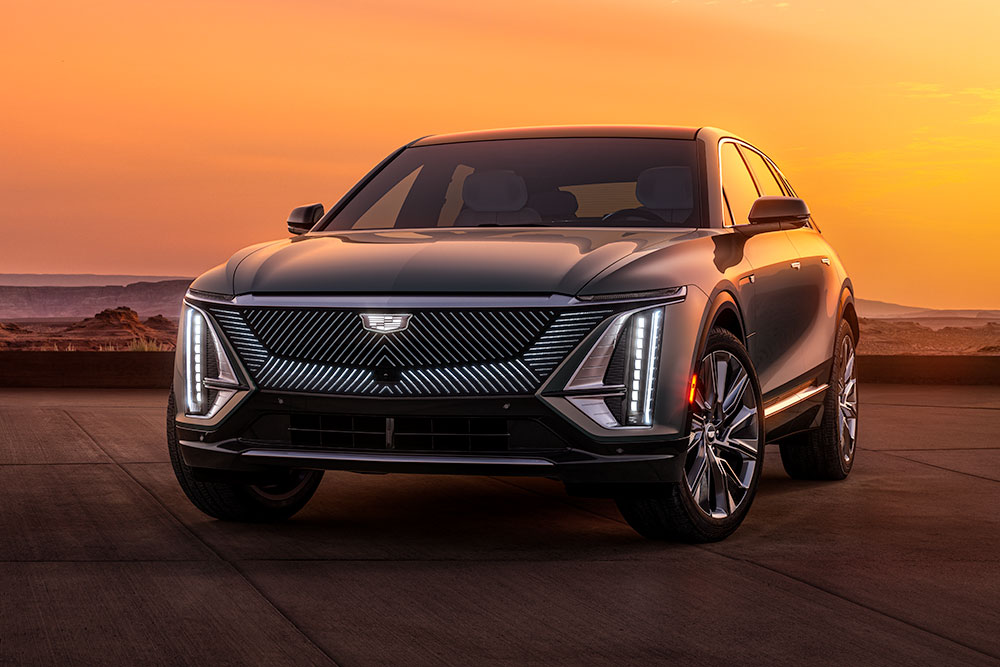Five new car models to look out for in 2025
From much-anticipated dual-cab utes to a luxury EV, check out some of the most interesting new cars headed our way.
.jpg?h=667&iar=0&w=1000&rev=43711bd1a57e47e4a8f4ecb99eb3c1c9&hash=E4AB7834E08D6F52769269EEF812E437)
With the Commonwealth Government’s New Vehicle Emissions Standard (NVES) due to come into effect on 1 January 2025, the new year promises to bring a wave of new models from both established car makers and new brands.

Kia Tasman
Unless you’ve been living under a rock, you’re no doubt already aware that Kia will launch a 4x4 dual-cab ute in mid-2025 that’s intended to do battle with the likes of the Ford Ranger and Toyota HiLux.
The Kia Tasman has famously been teased for months courtesy of one of the most memorable television advertising campaigns in recent memory featuring a star-studded roster of Aussie sporting greats.
Aside from its polarising design, the bluff-fronted Tasman ute will feature a category standard mechanical layout comprising a sturdy body-on-frame construction with independent front suspension and a load-oriented leaf-sprung live-axle rear-end.
Under the bonnet is a 2.2-litre four-cylinder turbo-diesel engine putting out a competitive 151kW/441Nm.
The engine will be mated to an eight-speed automatic transmission and drive through either 4x2 or dual-range 4x4 systems.
Like its rivals, the Tasman will be available with a choice of single-cab-chassis, double-cab-chassis and dual-cab pick-up body styles.
Pricing for the new model hasn’t been released but expect entry level variants to start in the high $40,000s ranging up to high $70,000s for the top-spec variants.

BYD Shark 6 (PHEV)
Another dual-cab 4x4 ute that’s been generating plenty of headlines is the Chinese-made BYD Shark 6, which recently won the race to be Australia’s first petrol-electric plug-in hybrid (PHEV) ute.
It appears there’s plenty of demand for the fuel-saving low-emission technology, too, with BYD distributor EVDirect claiming to have taken more than 4,000 orders for the new ute since the books opened in October.
Featuring chunky 4x4 looks characterised by a bluff grille, wheel-arch flares and angular styling, the Shark 6 promises up to 800km of combined-cycle driving courtesy of its twin electric motors, 29.58kWh LFP battery, and 1.5-litre turbo-petrol engine.
Priced from a keen $57,900 (plus on-road costs) the BYD Shark 6 will undercut the Ford Ranger PHEV (see below) which is expected to start from $70,000 for the entry-level XLT grade.
Constraining demand somewhat is the fact the Shark 6 currently has a tow rating of 2,500kg, but a 3,500kg towing upgrade is reportedly in the pipeline.
.jpg?rev=f1321c336bd5485bb21be1506cd3561e&hash=5F9BC84EB8A2B58654B3A7A2B73FA293)
Ford Ranger (PHEV)
Still on utes, Ford’s best-selling Ranger will gain new variants in 2025 with the inclusion of the Blue Oval’s own plug-in hybrid electric (PHEV) drivetrain technology.
Due in mid-2025, the Ranger PHEV’s new powertrain combines a 2.3-litre turbocharged four-cylinder EcoBoost petrol engine and 10-speed automatic gearbox with a 75kW electric motor and 11.8kWh (usable) battery.
The combination delivers a claimed electric-only driving of over 45km, while maintaining the ICE-powered Ranger’s full 3,500kg braked towing capacity and off-road ability, according to Ford.
Search and compare new cars
Unlike the rival BYD Shark 6, which uses dual electric motors to deliver its all-wheel drive ability, the Ranger PHEV features a more conventional dual-range transfer case and rear differential lock for enhanced off-road performance.
Ranger PHEV’s Pro Power Onboard feature enables users to power high-draw tools and appliances directly from the onboard battery, rather than needing a generator.
It will be offered in Wildtrak, Sport and XLT grade trims series, as well as a PHEV-exclusive Stormtrak launch edition, with pricing ranging from an estimated $70,000 for the entry-level XLT, on to $90,000 for the fully-loaded Stormrak.
The latter’s unique design elements include 18-inch alloy wheels, honeycomb grille, fender vents, decal kit, Matrix LED headlamps, Flexible Rack System, Pro Trailer Backup Assist and a 360-degree camera as standard.

Hyundai Inster (EV)
Hyundai’s all-electric sub-compact EV, the Inster, is due here in February 2025 and will slot in under the brand’s existing Kona Electric as its entry level electric offering.
Described by the manufacturer as a sub-compact urban EV, the Inster’s boxy styling is underpinned by an extended wheelbase, with the compact body designed to maximise occupant and luggage space.
The front-row seating provides walk-through access to the second row, with all seats including the driver’s seat, able to be folded flat for increased flexibility.
Elsewhere inside, the Inster features a 10.25-inch digital cluster and a 10.25-inch infotainment touchscreen with navigation and a wireless charging dock integrated into the compact centre console.
Both Standard Range and Extended Range variants will be available with different battery capacities and wheel sizes.
The Inster Standard Range rides on 15-inch wheels and is powered by a 42kWh battery and 71kW/147Nm electric motor, providing a driving range of 327km (WLTP).
Stepping up to the Extended Range brings 17-inch alloys, a larger-capacity 49kWh battery, more-powerful 85kW/147Nm motor for slightly lower 360km range (WLTP).
Hyundai hasn’t released official pricing, but information leaked earlier this year suggests the Inster will be priced between $40,000 and $45,000 (driveaway) depending on battery and model variant.

Cadillac Lyriq (EV)
For those looking to add a little luxury to their EV experience and tired of the established offerings, US prestige-car icon Cadillac will arrive Down Under in 2025 with its Lyriq EV.
A large five-door, five-seat SUV built on GM’s modular Ultium electric vehicle platform, the Lyriq will finally realise GM’s long-held dream to launch the Cadillac brand in Australia, after several false starts.
First launched in the US in 2022 the Lyriq was hailed as the first all-electric vehicle from the US luxury car maker and is designed to be in the vanguard of what will eventually become a full range of battery-electric models.
Rivals here include the BMW iX, Genesis GV60 and GV70, Polestar 3 and Mercedes-Benz EQE, with the Lyriq’s price point designed to be competitive with these rivals.
The Lyriq will be offered in Luxury and Sport variants, with the Luxury available from $117,000 (MRLP) and the Sport from $119,000 (MRLP). Both offer an impressive 388kW of power delivered via an all-wheel drive electric powertrain featuring a 102kWh battery capable of 530km (WLTP) between charges.
Other notable features include 21-inch alloy wheels, a curved 33-inch diagonal advanced LED display, an AKG Studio 19-speaker audio system and a full glass roof with power sunshade.
The Lyriq will be distributed in Australia by GMSV (General Motors Special Vehicles), which already sells the Silverado pickup and Corvette sports car range and has recently confirmed local conversion of the eight-seat GMC Yukon SUV.
Unlike the Silverado and Yukon, however, the Lyriq is built in factory right-hand drive at the Spring Hill Manufacturing Plant in Tennessee, USA.
Like rival Tesla, Cadillac will pursue an online sales model with customers able to specify and order the vehicle online, or at dedicated ‘Experience Centres’ in Sydney and later Melbourne.
Related topics
Things to note
The information in this article has been prepared for general information purposes only and is not intended as legal advice or specific advice to any particular person. Any advice contained in the document is general advice, not intended as legal advice or professional advice and does not take into account any person’s particular circumstances. Before acting on anything based on this advice you should consider its appropriateness to you, having regard to your objectives and needs.
Insurance Products (excluding Travel Insurance) are issued by RACQ Insurance Limited ABN 50 009 704 152 (RACQI) and arranged by its agent, RACQ Distribution Services Pty Ltd (RDS) ABN 35 116 361 650, AFSL 567130 and RDS' authorised representatives (including RACQ Operations Pty Ltd ABN 80 009 663 414, AR No. 234978 (RACQO). Conditions, limits and exclusions apply. RDS and RACQO are in the RACQ group of companies. One of the companies in the RACQ group of companies has a minority shareholding in RACQI.
RDS and RACQO have not taken your personal objectives, circumstances or needs into account when preparing advice regarding insurance products and you will need to consider whether the advice is appropriate for you. Read the Product Disclosure Statement (PDS) and any applicable Supplementary PDS before making a purchase decision on this product. You can also access our Target Market Determinations on this website. RDS receives a commission from RACQI for the policies it arranges. RACQO receives fees paid for services it provides to RDS. Further details about remuneration are available on request prior to purchasing.
Banking and loan products issued by Members Banking Group Limited ABN 83 087 651 054 AFSL/Australian credit licence 241195 trading as RACQ Bank. Terms, conditions, fees, charges and lending policies apply. This is general advice only and may not be right for you. This information does not take your personal objectives, circumstances or needs into account. Read the disclosure documents for your selected product or service, including the Financial Services Guide and the Terms and Conditions, and consider if appropriate for you before deciding.
Except for RACQ Bank, any RACQ entity referred to on this page is not an authorised deposit-taking institution for the purposes of the Banking Act 1959 (Cth). That entity’s obligations do not represent deposits or other liabilities of RACQ Bank. RACQ Bank does not guarantee or otherwise provide assurance in respect of the obligations of that entity, unless noted otherwise.
RACQ Bank subscribes to the Customer Owned Banking Code of Practice which establishes higher standards than the law requires. The Code reflects modern consumer expectations and developments in approaches to issues such as consumer vulnerability, guarantors, and supporting customers through financial hardship. Please read our Customer Owned Banking Code of Practice page for more information.
RACQ Operations Pty Ltd (ABN 80 009 663 414 AR 000234978) and Members Travel Group Pty Ltd (ABN 45 144 538 803 AR 000432492) are acting as an Authorised Representative of the issuer of the insurance, Tokio Marine & Nichido Fire Insurance Co., Ltd. (ABN 80 000 438 291 AFSL 246 548). Any advice set out above is general in nature only, and does not take into account your objectives, financial situation or needs. Before purchasing any travel products, please consider the RACQ Travel Insurance Product Disclosure Statement (PDS) and the Target Market Determinations (TMDs) that apply to these products. Whilst the PDS outlines the Terms and Conditions of these products, the TMDs outline the intended class of customers that comprise the target market for these travel products. This will allow you to consider which products best suit your objectives, financial situation and needs and consider the products appropriateness to your personal circumstances. TMDs also outline matters involving the distribution and the review of these products. The PDS, Supplementary PDS and TMDs for each travel product can be found here.
